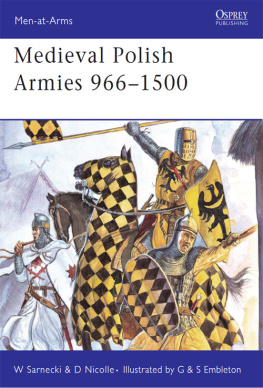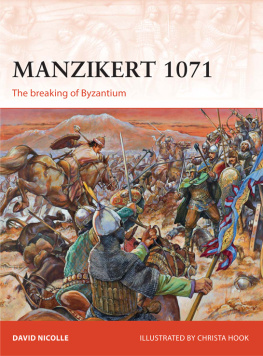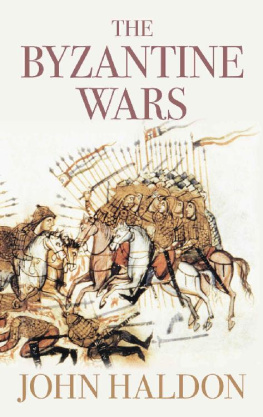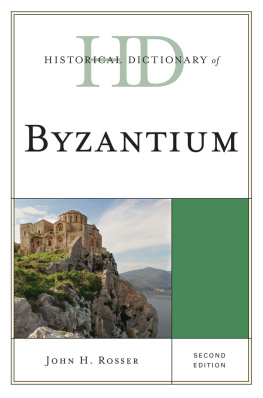First published in Great Britain in 2010 by
PEN & SWORD MILITARY
an imprint of
Pen & Sword Books Limited
47 Church Street
Barnsley
S. Yorkshire S70 2AS
Copyright David Nicolle, 2010
ISBN 978 1 84415 954 3
Print ISBN: 978-1-84415-954-3
ePub ISBN: 9781844687602
The right of David Nicolle to be identified as Author
of this Work has been asserted by him in accordance
with the Copyright, Designs and Patents Act 1988.
A CIP catalogue record for this book
is available from the British Library
All rights reserved. No part of this book may be reproduced or
transmitted in any form or by any means, electronic or mechanical
including photocopying, recording or by any information storage
and retrieval system, without permission from the Publisher in writing.
Typeset in Times New Roman by S L Menzies-Earl
Printed and bound in England
by CPI
Pen & Sword Books Ltd incorporates the imprints of
Pen & Sword Aviation, Pen & Sword Maritime,
Pen & Sword Military,Wharncliffe Local History, Pen & Sword Select,
Pen & Sword Military Classics, Leo Cooper, Remember When,
Seaforth Publishing and Frontline Publishing
For a complete list of Pen & Sword titles please contact:
PEN & SWORD BOOKS LIMITED
47 Church Street, Barnsley, South Yorkshire, S70 2AS, England.
E-mail:
Website: www.pen-and-sword.co.uk
List of Illustrations





Introduction

History is full of stories of remarkably rapid conquests, often achieved by small numbers against numerous and varied foes. In the great majority of such cases, however, the conquests thus achieved were almost as rapidly lost once again. The extraordinary expansion of the Ottoman state between the mid-fourteenth and mid-fifteenth centuries is not one of these stories. It was followed by further expansion both in Europe and, with similarly dramatic speed, in the Middle East and North Africa. What is even more significant is the fact that these awe-inspiring military achievements were followed by more than three centuries of consolidation, then by a prolonged rather then precipitous decline.
As a result the Ottoman Empire, as it became, has left a deep impact upon south-eastern Europe, the Middle East, North Africa and beyond; an impact visible in cultural, religious, political and military terms to this day. Within this long and fascinating history, no period is more dramatic and in many ways mysterious than the century between the first Ottoman troops taking control of a small part of the Gallipoli Peninsula and the fall of the final remnants of the age-old Romano-Byzantine Empire. The latter was a more complicated event than is generally realized, there being two Byzantine Empires in existence at that time, plus other fragments or enclaves. Undoubtedly the most important single episode in this collapse was the Fall of Constantinople in 1453, which occurred less than twohundred and fifty kilometres from inbi where those first Ottoman soldiers set up the Ottoman flag around 1352. By 1453, of course, the frontiers of the Ottoman Sultanate, as it then was, had stepped beyond the river Danube, had reached the Adriatic Sea and already encompassed almost half of modern Turkey.
The Ottoman state already had more than half a century of history behind it when it crossed the Dardanelles Strait from Asia to Europe, and this little-recorded early period laid the foundations of what was already in many vital respects a European as well as an Asiatic political, military and cultural system. It could even be said that it was this early combination of east and west which planted the seeds of Ottoman success and durability. This was then followed by a century of remarkable expansion, which began when a tiny force of Ottoman Turkish warriors was invited by a Greek, Byzantine, Christian Emperor to cross the Dardanelles from Asia into Europe to assist him in one of the civil wars which were tearing apart the fast-declining Byzantine Empire. Almost exactly a century later the imperial Byzantine capital of Constantinople fell to what had grown into a hugely powerful and expanding Turkish and Islamic state. Furthermore, the Ottoman rulers of this new state came to see themselves as the natural and legitimate heirs of their Byzantine and indeed Roman predecessors. As a result they became in name and title, as they already were in fact, Emperors.
During the intervening hundred years there had been many other participants in this epic story, winners as well as losers, Christians and Muslims. They included local inhabitants and western European newcomers or settlers, as well as rulers, merchants, long-established local aristocracies and military elites, and resident rural and urban populations who were themselves descended from numerous preceding waves of conquest or migration. Meanwhile the new Ottoman settlers were of similarly mixed cultural or linguistic origins.
Chronology

| c.1280 | Death of Ertu rul, Osman I becomes ruler (bey and subsequently emir) of first Ottoman state. rul, Osman I becomes ruler (bey and subsequently emir) of first Ottoman state. |
| 1301 | Ottoman victory over Byzantines at Koyunhisar (Bapheon). |
| 1326 | Ottomans capture Bursa; Orhan Gazi becomes Ottoman ruler (emir). |
| 1338 | Ottomans capture skudar (Scutari). |
| 1345 | Ottomans occupy Turkish beylik (small state) of Karesi; Ottoman force crosses Dardanelles at invitation of Byzantine Emperor. |
| 1353-5 | Ottomans occupy inbi, Gallipoli and neighbouring towns. |
| 1359 | Murat I becomes Ottoman ruler; Ottoman occupation of Ankara. |
| 1361 | Turks (not necessarily under the Ottoman rulers direct control) conquer Edirne. |
| 1364 | Ottomans defeats Balkan Christian alliance at River Marica. |
| 1365 | Ottomans move capital from Bursa to Edirne. |
| 1371-76 | Ottoman conquest of western Thrace and (Greek) Macedonia. |
| 1376 | Bulgarian states become Ottoman vassals. |
| 1388 | Dobruja becomes Ottoman vassal. |
| 1389 | Ottomans defeat Serbians at First Battle of Kosova (Kosovo); Bayezit I becomes Ottoman ruler, asserts independent sovereignty as Sultan; Serbia and Bosnia become Ottoman vassals. |
| 1390 | Ottomans conquer Turkish beyliks of Sarahan, Aydin, Mente e, Hamit, Germiyan, Teke and part of Karaman in Anatolia. e, Hamit, Germiyan, Teke and part of Karaman in Anatolia. |
| 1391 | Wallachia becomes Ottoman vassal. 1392-98 Ottomans conquer Turkish beyliks of Konya, Sivas and Kastamonu in Anatolia; Ottomans conquer Thessaly in Balkans. |



















 rul, Osman I becomes ruler (bey and subsequently emir) of first Ottoman state.
rul, Osman I becomes ruler (bey and subsequently emir) of first Ottoman state. e, Hamit, Germiyan, Teke and part of Karaman in Anatolia.
e, Hamit, Germiyan, Teke and part of Karaman in Anatolia.